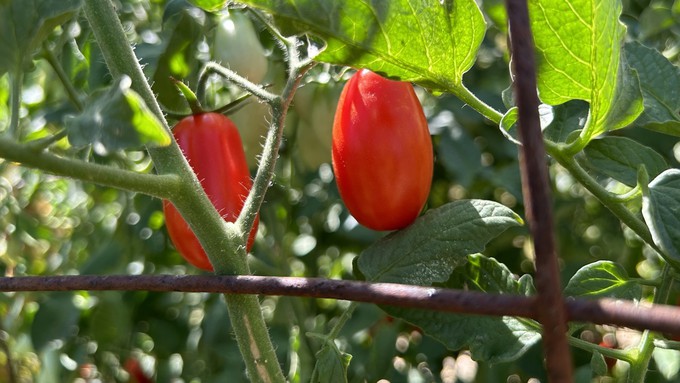
More triple-digit heat coming soon; plan accordingly

Tasty and prolific, Juliet tomatoes hold well on the vine. But harvesting encourages continued fruit set. Kathy Morrison
Hopefully, you got what you needed to get done last week because we’re going to start heating up again.
After some pleasant days in the mere 80s, we’re headed back to triple digits. According to the National Weather Service, Sacramento is expected to hit 105 on Tuesday. That’s 14 degrees above normal for mid August. But by Friday, we’ll be back down to a forecast high of 90 degrees – and a very pleasant weekend.
This spiky heat can play havoc with tomatoes; they can’t set new fruit when it tops 95 because their pollen dries out. But the warmth will bring on rapid ripening of fruit that’s already on the vine. Keep plants picked and hydrated.
Until temperatures cool back down, plan to take care of garden tasks in the morning, then retreat indoors out of the sun. Most chores can wait until then.
* What can’t wait: Ripe veggies and fruit. Harvest tomatoes, beans, squash, pepper and eggplants to prompt plants to keep producing.
* Give your plants a deep watering twice a week, more if planted in containers. Also, give these veggies a boost with phosphate-rich fertilizer to help fruiting. (Always water before feeding.)
* Watch out for caterpillars and hornworms in the vegetable garden. They can strip a plant bare in one day. Pick them off plants by hand in the early morning or late afternoon.
* Pick up after your fruit trees. Clean up debris and dropped fruit; this cuts down on insects and prevents the spread of brown rot. Then feed fruit trees with slow-release fertilizer for better production next year.
* Mulch can be your garden's best friend – it conserves moisture while blocking out weeds. But don't let mulch mound around stalks, stems or trunks. That can promote rot.
* Feed citrus trees their last round of fertilizer for the year. This will give a boost to the fruit that's now forming.
* Camellia leaves looking a little yellow? Feed them some chelated iron. That goes for azaleas and gardenias, too.
* Pinch off dead flowers from perennials and annuals to lengthen their summer bloom.
* To prolong bloom into fall, feed begonias, fuchsias, annuals and container plants.
* Fertilize fall-blooming perennials, too. Chrysanthemums can be fed until the buds start to open.
* Cut off spent blooms from roses, then give them a boost of fertilizer. Roses will rebloom about six to eight weeks after deadheading.
* Indoors, start seedlings for fall vegetable planting, including bunching onion, cabbage, broccoli, cauliflower, kale, radicchio and lettuce.
* Sow seeds of perennials in pots for fall planting including yarrow, coneflower and salvia.
* In the garden, direct seed beets, bush beans, carrots, leaf lettuce, radishes and turnips.
* Plant potatoes.
Comments
0 comments have been posted.Sacramento Digs Gardening to your inbox.
Sites We Like
Garden Checklist for week of July 21
Your garden needs you!
* Keep your vegetable garden watered, mulched and weeded. Water before 8 a.m. to reduce the chance of fungal infection and to conserve moisture.
* Feed vegetable plants bone meal, rock phosphate or other fertilizers high in phosphate to stimulate more blooms and fruiting. (But wait until daily high temperatures drop out of the 100s.)
* Don’t let tomatoes wilt or dry out completely. Give tomatoes a deep watering two to three times a week.
* Harvest vegetables promptly to encourage plants to produce more. Squash especially tends to grow rapidly in hot weather. Keep an eye on zucchini.
* Pinch back chrysanthemums for bushy plants and more flowers in September.
* Remove spent flowers from roses, daylilies and other bloomers as they finish flowering.
* Pinch off blooms from basil so the plant will grow more leaves.
* Cut back lavender after flowering to promote a second bloom.
* It's not too late to add a splash of color. Plant petunias, snapdragons, zinnias and marigolds.
* From seed, plant corn, pumpkins, radishes, winter squash and sunflowers.